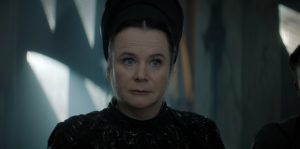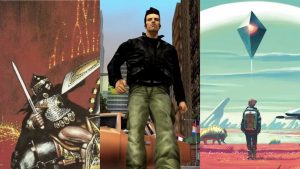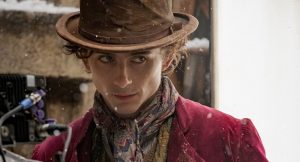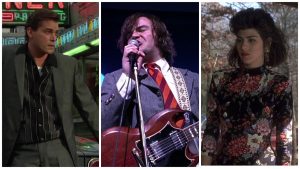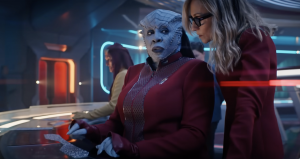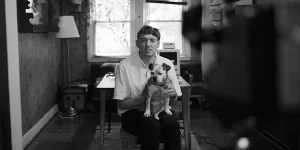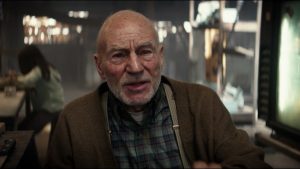
The Immortan, the man who every War Pup and wretch in the Citadel was raised to worship, is dead. Less a warlord than a god among insects prior to this moment, Hugh Keays-Byrne’s villain ruled the Citadel with an iron fist. Yet when instead of Joe’s hulking figure, it is the silhouettes of Max Rockatansky (Tom Hardy) and the Imperator Furiosa (Charlize Theron) who emerge from his car, screams of delight rush through the throngs of unwashed masses.
The king is dead. Long live the queen. Maybe. It would seem Furiosa will at least have an opportunity to rule as she and the surviving Wives of the Immortan, plus a handful of the Many Mothers, ascend back up the Citadel. But as Furiosa raises ever higher above the crowd, she notices something: Max is no longer by her side. The laconic drifter has escape, vanishing into the mob. He is returning to his home, to his Wasteland.
It is a perfect ending for a perfect action movie. Max is forever the warrior and brute who walks alone. He can help save the remnants of civilization, and grasp strands of hope from the red waste’s seas of despair… but he never gets to emerge from that ruin. This is the final epiphany in George Miller’s Mad Max: Fury Road, a film that looks all the more like a miracle when you know the years and decades of hardship, false starts, and delays the project faced. Through it all, Miller’s kinetic vision remained strong and undiluted. In fact, it wound up being refined right up until the end, including with that iconic closing shot.
It’s interesting to consider, then, what it might look like if Miller had made the movie when he originally hoped, at the turn of the millennium with Mel Gibson back behind the wheel of the Interceptor. The film could have even had an entirely different ending for Max and Furiosa.
Mel Gibson’s Journey On and Off the Fury Road
The germ of pursuing a fourth Mad Max movie goes back to at least the 1990s when George Miller, fresh off seeing the sci-fi movie Contact taken away from him, began entertaining the idea of returning to the Australian desert for one last ride with Max in his “Black on Black” Interceptor. Actually, he was approached at first to make a Mad Max syndicated television series in the vein of Xena: Warrior Princess, but the director quickly pivoted to an idea he had back during the making of The Road Warrior: what if there was a Mad Max movie that was a wall-to-wall chase film?
Over the next several years, a branching collaboration of filmmakers, artists, and storytellers helped him conceive the basis of what became Mad Max: Fury Road. And if everything had gone smoothly, the film would have been released in the early 2000s with Mel Gibson back in the role of Max Rockatansky.
“George, it’s fucking fantastic and I love it,” lead storyboard artist Mark Sexton recalled Gibson saying one afternoon in 2001. At the time, Gibson had just looked over thousands of storyboards and sketches that Miller and his co-writers had turned into their ‘screenplay’ for Fury Road. To read it, one had to travel all the way down to Miller’s office in Sydney. Gibson did just that when he said, “But we’ve got to get this going now, because I’m nearly 50, and I don’t even know if I can do it now, let alone in five or six years.”
It of course did not get going either then or five or six years later. As recounted in the same book with Sexton’s memories, Kyle Buchanan’s excellent Blood, Sweat & Chrome: The Wild and True Story of Mad Max: Fury Road, this movie was an odyssey of false starts and production derailments. The first of which being an intended production start in the Namib desert—the same southern African waste that would eventually prove to be the location backdrop of Fury Road—falling apart in the early 2000s. After the terrorist attacks on Sept. 11, 2001, studio executives, plus reportedly Gibson himself, got cold feet about filming in a predominantly Muslim country, and the project was delayed long enough for Gibson to age out of the role—and to also reveal horrible dark sides of his nature to the public.
However, the ending the filmmakers originally conceived of for Mad Max, chiefly Gibson’s Mad Max, would carry on through Fury Road’s many twists and turns in the years to come.
The Original Mad Max: Fury Road Ending
“In the storyboarding phase, it was all of them going up on the platform, and Max is there supporting Furiosa,” Sexton revealed in Blood, Sweat & Chrome. “This was in the iteration where it was supposed to be Mel Gibson, and so it was really considered to be the end of Max’s story. He’s now become reintegrated into society and regained his humanity. He wants to become part of a greater thing as opposed to being a loner, and he is going up toward ultimate salvation.”
It’s a striking departure from what the Mad Max: Fury Road ending became, and how every Mad Max movie before it concluded. From the original Mad Max of 1979 through Mad Max Beyond Thunderdome (1985), the character played by Gibson always ends his stories alone and isolated from those he helped. While he reluctantly became the hero of the Waiting Ones in Thunderdome, he didn’t get to fly with them to the city. He ends his stories as he begins, in search for something that will never come. However, if Mad Max: Fury Road had capped the end of Max Rockatansky’s journey, there might have been something therapeutic about him finding solace and peace—redemption, as Furiosa says of her own motivation.
“They went back and create this Green Place together, these amazing tiers of huge, almost rainforest-style greenhouse gardens in the Citadel, super lush, with all different types of vegetables and plants. Then they can have offspring of their own and provide food for the family and everyone else,” camera operator Mark Goellnicht remembered. He also quickly added, “How corny. Can you imagine? No. Totally dumb.”
The idea of giving Max that happy ending indeed became a point of contention throughout the production, with Furiosa star Charlize Theron musing they never had an ending during the shoot. What was there simply appeared to be a “sketched-out idea.” Meanwhile Miller’s co-writer on the film’s earliest drafts, Brendan McCarthy, said Miller told him that there would come a point when the characters would start to live and tell the storytellers where their journey concluded.
As it turned out, they would have some help.
Why the Ending Changed
George Miller never got to shoot the loose original ending he had in mind for Mad Max: Fury Road, happily ever after and all. At least not the way he intended. This was the result of the then head of Warner Bros. Pictures, Jeff Robinov, turning up in person in Namibia after Fury Road had been filming in the desert for four months. Unhappy with the dailies he was seeing and at the rate of progress on the production—and perhaps because he was losing his chance at moving up the ladder to become chairman and CEO of Warner Bros. Entertainment in a political battle worthy of Game of Thrones—Robinov demanded Fury Road finish production by early December or he’d shut Miller down.
The only way to get there would be by scrapping the intended beginning or ending, or at least severely rewriting it. While Miller had originally penned the beginning of the film viewers are now aware of, not a frame of Fury Road’s Citadel scenes had been shot when Robinov arrived in Africa. So to finish the film “on time,” there would be some hasty rewrites for the few Cape Town sets WB still afforded Miller to use.
“We never shot that ending,” art director Shira Hockman said. “We got to the point when they arrived all together, where Max is carrying Furiosa, and they go back into the hydroponics set. We shot that without sound because George already knew it wasn’t going in, but we had spent so much money on those rigs we just shot it anyway.”
Assistant director P.J. Voeten seemed to agree with this version of events when he told Buchanan it was the only time he ever saw Miller do just one take. “This is never going to be in the film,” the director apparently said.
However, the delay in filming an actual beginning and ending to Mad Max: Fury Road ended up being in the movie’s favor. In addition to the post-production process lasting long enough for Robinov to lose his war for the throne—and the victor, Kevin Tsujihara, greenlighting reshoots in Sydney that would actually make Fury Road comprehensible—it also gave Miller and his editor and wife, Margaret Sixel, time enough to find the movie in the editing suite and know what the ending needed to be.
“All the way through the shoot, I thought Max will go up there with Furiosa and the remaining Wives, and there will be a new disposition,” Miller explained. “But it was much better for Max to go off into the Wasteland in search of himself, just as he always did. It’s an ending that fits with the rest of the movie much better.”
The filmmaker eventually added that he and the dramaturg who became his final co-writer on the film, Nico Lathouris, deemed Max to be unprepared for peacetime.
“He was not ready to love somebody,” Lathouris said. “It almost happens with Furiosa, but he’s not ready for that kind of life. He hasn’t learned the lesson yet about grieving.”
Meanwhile Sexton was astute to point out that this was a new Mad Max played by Tom Hardy. He was younger, and there was the option of making more movies as a “continued story.” So, as was the case at the end of previous films, Max returns to the desert while Furiosa ascends with a new, and hopefully better, world.
… Although for a time even that was also in doubt.
One Last Discarded Twist
While the full-fledged happy ending Miller had sketched out between Furiosa and Max was never filmed, one element was: Zoe Kravitz’s Toast the Knowing, the smartest and most learned of Immortan Joe’s wives, was originally intended to supplant the bruised and beaten Furiosa as leader of the Citadel.
“Initially, whenever the Immortan arrived, the crowd would point to him and start chanting, ‘He. He. He.,’” Miller explained. “What [Kravitz’s] Knowing did at the end of our original story was push her way to the front of the platform, cover herself in cobalt blue, and raise her hand as if she was going to be the new leader. The crowd below, as the platform rises, is calling out, ‘She. She. She.’”
Sexton recalled that even in the earliest storyboards Miller was preoccupied by the idea of what goes around comes around.
“What you intend as a noble line of pursuit can easily turn into the thing that you’ve tried to get rid of,” Sexton said. “And then the very last shot was Max on the platform supporting Furiosa, who’s still pretty banged up, and he looks toward the viewer and breaks the fourth wall as if to say, ‘Watch out. Watch out for the snake in the grass.’”
Yet, at least by how Miller tells it, what seemed like a neat idea on the page turned into a false note while editing the film.
“It made sense that Furiosa alone ascends to the top of a dominant hierarchy,” Miller said. “The question becomes what is she going to do with it?” This is a question Miller previously told me he always liked to leave up to viewers. Even before Furiosa’s box office troubles, Miller preferred the idea of ending her story on that ascent and leaving viewers to determine for themselves whether she will build a new utopia out of the Immortan’s ruins or if the long despair of history will continue.
“Can she improve it?” Miller told Den of Geek. “Or is she going to do what often happens in many stories where there is some revolution. As [Joseph] Campbell said, ‘Often yesterday’s hero becomes tomorrow’s tyrant.’ And that’s a story told over and over again as well.” It is an end and, maybe, a new beginning. But it is up to you what kind.
The post Mad Max: Fury Road Would Have Radically Different Ending with Mel Gibson appeared first on Den of Geek.
